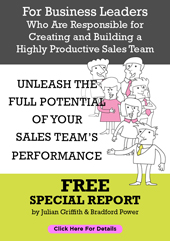Below is a selection of posts from Lisa Rubinstein’s Blog, enjoy!
Your Own Worst Enemy
At a recent dinner party we swapped customer service horror stories. One stood out as a great warning to us all.
After selling their home, this couple had contacted various real estate agents to inquire into purchasing a new property. Cashed up and eager to buy, they kept encountering agents who seemed intent on turning away their business.
One agent kept insisting they call back to set up an appointment. Another said the property could on be viewed by appointment, but wouldn’t specify when. Yet another property with a listed viewing time was locked and the agent refused to come by and open it up. Even with willing customers ready to look.
Am I missing something here? Is the property market so hot that agents can afford to push away eager buyers with ready cash? More likely they were unaware of how they were shooting themselves in the foot.
How do you sabotage your own business success?
A recent SEEK survey of 10,000 Australians revealed that, even with the economic downturn, 55% of employees were keeping their eyes open for other opportunities. Only 12% loved their bosses while 25% said the thing they hated most about their jobs were the stress levels and overall management.
What are you doing that doesn’t work and that you don’t know you don’t know doesn’t work? How do you even discover what you don’t know you don’t know?
Our minds are like a black bag. You can’t see what’s inside and can’t access an issue until you’re ready to reach in and pull it out. It’s a simple act of self-preservation that keeps us sane, but limits our growth and development.
Then how do you access those black bag blind spots?
Start by looking at what’s not working. Ask around, look at results and turn over a few rocks.
Even better, get someone in from outside your culture to poke around a bit and find the real answers you’ll never discover on your own. There is a large gap between what employees will say to their managers and what becomes coffee talk.
In today’s business climate there’s no room for hiding your head in the sand and pretending it’s all fine. You never want to be the dinner party horror story.
Pushing Buttons
It’s been a hectic month for me, most recently due to some fairly intense training I’m participating in. Since 1994, I have been in some form of training, either delivering or participating in, around leadership and performance.
This one really knocks my socks off. Yesterday, we did an exercise designed to remove any negative triggers while public speaking. It’s something I recommend to anyone who ever gets annoyed, rattled, triggered or in any way unsettled.
What pushes your buttons at work or home? What behaviours by others can either mildly annoy you or really send you over the edge?
Consider this: people are just your projections. Their behaviours and actions show up a certain way around you simply because that is how you view them. it’s not because that is who they are and the whole world will see this. Trust me, if that were so, everyone would want to be married to your partner. (If you’re currently not happy with them, remember when you were.)
The ones you can’t tolerate simply are displaying an aspect of yourself that you don’t want to acknowledge exists.
So, if you are a highly productive person, always on the go and are completely intolerant of anyone you perceive as lazy. It’s a bit of you showing up. If you are really efficient and hate people who are time poor…
This one is my favourite. Anyone reading this particularly tolerant and compassionate and get really upset around judgmental people? Don’t you just hate judgmental people? Well….
Anyone around you particularly irritating? That’s another little bit of you showing up.
Try this on. Anytime you experience irritation, annoyance, anger, frustration or whatever your favorite button is, try asking yourself “Where do I do the same thing?”
If you can’t figure it out, ask your partner in work or life. But, be generous with them when they tell you.
Hats off to Tad and Adriana James. They run a truly professional and highly effective trainers training. After 15 years with some of the best of the best, I think this one tops the poll.
Fear of Change
Yesterday, I attended the AICC lunch panel discussion regarding the Emissions Trading Scheme and the move to a low carbon economy. In response to panel members’ call for certainty, I asked whether this was achievable and whether instead we should look for consensus.
This was not well-received.
I had the experience of being publicly chastised as they reinforced business’ demand for certainty. The heat of their response really spoke to a fundamental discomfort people have about change, and the drive to certainty to combat fears of the unknown.
But, the question still remains. In a highly complex situation with so many variables and wild cards, how can we create certainty? Take a moment for Paul Gilding’s view on ABC Radio.
Given our attachment to certainty, how are we going to deal with the potential climate changes that even the experts say are unpredictable? If we can’t change the circumstances, what can we do about our relationship to change?
I realise I am turning away from the panel member’s original intent with regards to regulations and laws. But the idea of certainty and human being’s attachment to it still applies.
Fundamentally, most people are uncomfortable with change. Some are so frightened of change they perpetuate a toxic situation, behaviour or relationship for fear of the unknown. They are blind to their fear and the impact it has on their ability to make the right decisions.
Fear of change stifles business ingenuity. Fear of change blunts any leaders’ ability to successfully implement necessary improvements to their business. Remember, culture eats strategy for lunch.
Human beings are extraordinary. Our capacity for innovative thinking and ingenuity is virtually limitless – as long as we can be with change.
How do we effectively deal with fear of change?
Distinguish the actual fear. Not the generalised experience of discomfort, but get to the specifics beneath it all. What is it exactly that you are upset about? Notice your concerns are really based on something that happened in the past which you’ve mapped onto the future.
Then, find the benefits of change. Keep listing benefits until they outweigh the fears. List at least 30 benefits. Tip the balance and you’ll find the fear dissolves away.
Knowledge brings clarity. Clarity brings power. Power brings freedom. Freedom allows for innovation, creativity and solutions.
Our environment is changing fast and we must continue to find creative solutions to keep up with these changes. We no longer have the luxury to dwell on our fears. They’re all behind you anyway.



